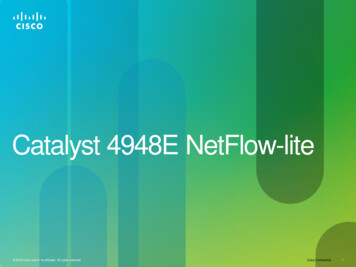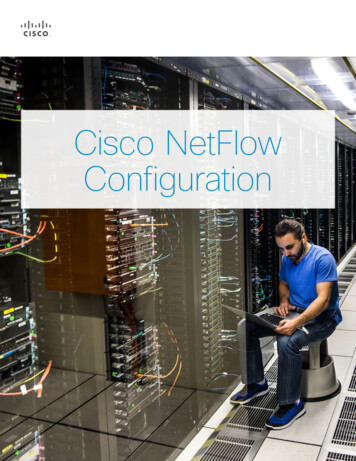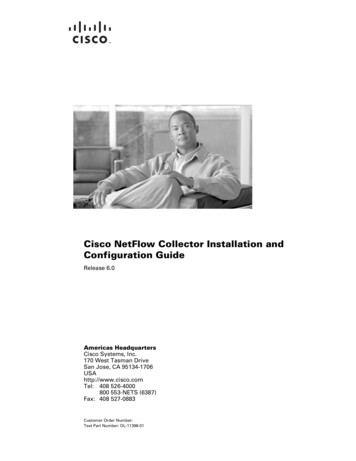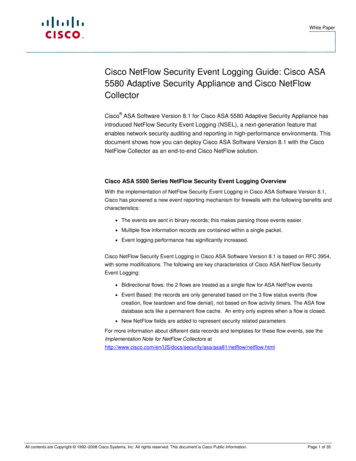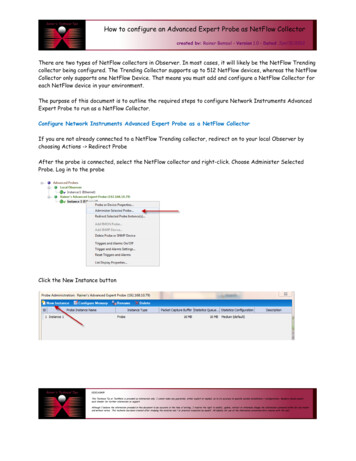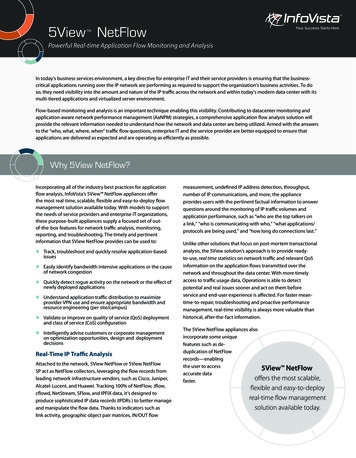
Transcription
Cisco NetFlow Collector User GuideRelease 6.0Americas HeadquartersCisco Systems, Inc.170 West Tasman DriveSan Jose, CA 95134-1706USAhttp://www.cisco.comTel: 408 526-4000800 553-NETS (6387)Fax: 408 527-0883Customer Order Number:Text Part Number: OL-11399-01
THE SPECIFICATIONS AND INFORMATION REGARDING THE PRODUCTS IN THIS MANUAL ARE SUBJECT TO CHANGE WITHOUT NOTICE. ALLSTATEMENTS, INFORMATION, AND RECOMMENDATIONS IN THIS MANUAL ARE BELIEVED TO BE ACCURATE BUT ARE PRESENTED WITHOUTWARRANTY OF ANY KIND, EXPRESS OR IMPLIED. USERS MUST TAKE FULL RESPONSIBILITY FOR THEIR APPLICATION OF ANY PRODUCTS.THE SOFTWARE LICENSE AND LIMITED WARRANTY FOR THE ACCOMPANYING PRODUCT ARE SET FORTH IN THE INFORMATION PACKET THATSHIPPED WITH THE PRODUCT AND ARE INCORPORATED HEREIN BY THIS REFERENCE. IF YOU ARE UNABLE TO LOCATE THE SOFTWARE LICENSEOR LIMITED WARRANTY, CONTACT YOUR CISCO REPRESENTATIVE FOR A COPY.The Cisco implementation of TCP header compression is an adaptation of a program developed by the University of California, Berkeley (UCB) as part of UCB’s publicdomain version of the UNIX operating system. All rights reserved. Copyright 1981, Regents of the University of California.NOTWITHSTANDING ANY OTHER WARRANTY HEREIN, ALL DOCUMENT FILES AND SOFTWARE OF THESE SUPPLIERS ARE PROVIDED “AS IS” WITHALL FAULTS. CISCO AND THE ABOVE-NAMED SUPPLIERS DISCLAIM ALL WARRANTIES, EXPRESSED OR IMPLIED, INCLUDING, WITHOUTLIMITATION, THOSE OF MERCHANTABILITY, FITNESS FOR A PARTICULAR PURPOSE AND NONINFRINGEMENT OR ARISING FROM A COURSE OFDEALING, USAGE, OR TRADE PRACTICE.IN NO EVENT SHALL CISCO OR ITS SUPPLIERS BE LIABLE FOR ANY INDIRECT, SPECIAL, CONSEQUENTIAL, OR INCIDENTAL DAMAGES, INCLUDING,WITHOUT LIMITATION, LOST PROFITS OR LOSS OR DAMAGE TO DATA ARISING OUT OF THE USE OR INABILITY TO USE THIS MANUAL, EVEN IF CISCOOR ITS SUPPLIERS HAVE BEEN ADVISED OF THE POSSIBILITY OF SUCH DAMAGES.CCVP, the Cisco logo, and Welcome to the Human Network are trademarks of Cisco Systems, Inc.; Changing the Way We Work, Live, Play, and Learn is a service mark ofCisco Systems, Inc.; and Access Registrar, Aironet, BPX, Catalyst, CCDA, CCDP, CCIE, CCIP, CCNA, CCNP, CCSP, Cisco, the Cisco Certified Internetwork Expert logo,Cisco IOS, Cisco Press, Cisco Systems, Cisco Systems Capital, the Cisco Systems logo, Cisco Unity, Enterprise/Solver, EtherChannel, EtherFast, EtherSwitch, Fast Step,Follow Me Browsing, FormShare, GigaDrive, HomeLink, Internet Quotient, IOS, iPhone, IP/TV, iQ Expertise, the iQ logo, iQ Net Readiness Scorecard, iQuick Study,LightStream, Linksys, MeetingPlace, MGX, Networkers, Networking Academy, Network Registrar, PIX, ProConnect, ScriptShare, SMARTnet, StackWise, The Fastest Way toIncrease Your Internet Quotient, and TransPath are registered trademarks of Cisco Systems, Inc. and/or its affiliates in the United States and certain other countries.All other trademarks mentioned in this document or Website are the property of their respective owners. The use of the word partner does not imply a partnership relationshipbetween Cisco and any other company. (0710R)Any Internet Protocol (IP) addresses used in this document are not intended to be actual addresses. Any examples, command display output, and figures included in thedocument are shown for illustrative purposes only. Any use of actual IP addresses in illustrative content is unintentional and coincidental.Cisco NetFlow Collector User Guide 2007 Cisco Systems, Inc. All rights reserved.
C O N T E N T SAbout This Guide viiObjective viiAudience viiHow This Guide Is Organized viiiCommand Syntax Conventions viiiObtaining Documentation, Obtaining Support, and Security Guidelines ixCHAPTER1-1Overview 1-1What Are NetFlow Services? 1-1NetFlow Services Device and IOS Release Support 1-2NetFlow Data Export 1-2How and When Flow Statistics Are Exported 1-2NetFlow Data Export Formats 1-3What Is Cisco NetFlow Collector? 1-4Cisco NetFlow Collector Architectural Overview 1-5Collector 1-6Web-Based User Interface 1-6Report Generator 1-6BGP Peer 1-6CHAPTER2-1Using the NetFlow Collector User Interface 2-1Starting the Cisco NetFlow Collector User Interface 2-1Customizing the Cisco NetFlow Collector Interface 2-2Using the Cisco NetFlow Collector User Interface 2-3The NFC Login Window 2-3Navigation 2-4Configuration 2-5Aggregators 2-7Adding Aggregators 2-7Editing an Aggregator 2-8Thresholds 2-9Fields 2-10Cisco NetFlow Collector User GuideOL-11399-01iii
ContentsKey Builders 2-11BGP Attribute 2-13Bit Field 2-14Boolean 2-14Byte Array 2-14Customer Name 2-15Egress PE 2-15Ingress CE 2-16Integer 2-16Integer Range Map 2-17Interface SNMP Name 2-17IP Address 2-17IP Address Range Map 2-18Mac Address 2-18Masked IP Address 2-18Multi-Field Map 2-19Option Data 2-20Site Name 2-20String 2-21Subnet Address 2-21Value Builders 2-21Active Time 2-23Directional Sum 2-23End Time 2-23Flow Count 2-23Max Flow Byte Rate 2-24Rate 2-24Start Time 2-24Sum 2-24Sum with Sampling Estimation 2-25Aggregation Schemes 2-25Filters 2-26NetFlow Export Source Groups 2-27NetFlow Export Source Access List 2-28BGP Peer 2-29Global 2-30Advanced 2-30Reports 2-31Custom Reports 2-32Report Templates 2-36Cisco NetFlow Collector User GuideivOL-11399-01
ContentsScheduled Reports 2-37Configuring Scheduled Reports 2-37Displaying Scheduled Reports 2-41Reporting Features 2-42Sorting and Graphing 2-43Trending 2-44Export and Print 2-45Filter 2-45Drill Down 2-45Status 2-45Control 2-46Statistics 2-46Health Monitor Statistics 2-46Port Statistics 2-47Source Statistics 2-48Logs 2-49CHAPTER3-1Understanding the NetFlow Collector Data File Format 3-1Data File Directory Structure 3-1Default Data File Directory Structure 3-1Options Data Directory File Structure 3-3Data Filenames 3-4Data File Format 3-4Backwards-Compatible Header 3-5XML Header Format 3-7Partial Data Files 3-8Options Data File Format 3-9Threshold Crossing Record File 3-10Using the filesready File to Track Data Files 3-10Options Data Filesready File 3-10Threshold Filesready File 3-11CHAPTER4-1Customizing the Cisco NetFlow Collector 4-1Configuration and Resource Files 4-1XML Configuration and Schema 4-1Data Collection and Aggregation 4-2Overview of NetFlow Collector Release 6.0 Configuration Information 4-3Fields 4-4Cisco NetFlow Collector User GuideOL-11399-01v
ContentsKeys and Values 4-4Key Builder Types 4-5Value Builder Types 4-13Key and Value Builder Data Types 4-15Creating an Aggregation Scheme 4-17Creating an Aggregator 4-18Creating a Filter 4-21Creating a Map 4-22Creating a Multi-Field Map 4-23Creating an Option Data Map 4-24Creating Source Groups 4-26Creating Access Lists 4-26Creating a Threshold 4-26Global Settings 4-28Setting the Time Zone 4-29Memory Usage 4-29Disk Space 4-31Filters 4-31Aggregation 4-31Data File and Disk Space Options 4-31Monitoring Disk Usage 4-32Process Watcher 4-32Configuration 4-33Event Service 4-34Configuration 4-34Scheduled Reports 4-35BGP Peer 4-38Starting and Stopping the BGP Peer 4-39Configuration 4-39Interface Name Support 4-40Packet Log 4-41Site In/Out Traffic Summary 4-42APPENDIXA-1Troubleshooting the Cisco NetFlow Collector A-1Using the nfcollector list Command A-1Using the show-tech Command to Capture Troubleshooting Information A-2NetFlow Collector Tools and Utilities A-2fdcount Utility A-2Cisco NetFlow Collector User GuideviOL-11399-01
Contentsndeget Utility A-3get bgp rib Utility A-3fdget Utility A-3fdplayback Utility A-4Solving NetFlow Collector Problems A-4APPENDIXB-1Logging B-1Configuration B-1Configuring the Logger from the Command Line B-2Rolling File Option for NFC Logs Files B-3Daily Rolling File Option for NFC Log Files B-3APPENDIXC-1Cisco NetFlow Collector Sample Work Flow C-1APPENDIXD-1NetFlow Fanout D-1Command Line Syntax D-1Configuration Note D-2APPENDIXE-1Cisco NetFlow Collector Binary Data File Format E-1APPENDIXF-1Cisco NetFlow Collector CNS/XML Interface F-1Cisco NetFlow Collector User GuideOL-11399-01vii
ContentsCisco NetFlow Collector User GuideviiiOL-11399-01
About This GuideObjectiveThe Cisco NetFlow Collector User Guide describes the Cisco NetFlow Collector application, which isused with the NetFlow services data export feature on Cisco routers and Catalyst switches. Thisdocument also describes the system requirements that must be met to install the Cisco NetFlow Collectorproduct, as well as, how to install, start, and configure Cisco NetFlow Collector.NetFlow services consist of high-performance IP switching features that capture a rich set of trafficstatistics exported from routers and switches while they perform their switching function. Cisco NetFlowCollector provides fast, scalable, and economical data collection from multiple export devices exportingNetFlow data records.Cisco NetFlow Collector, Release 6.0 introduces a tiered netflow collection architecture that providesincreased scalability and performance. The role of the first tier (Tier 1) maps to the NFC functionalityof Cisco NetFlow Collector 5.0.3 with the addition of new features described in Release Notes for CiscoNetFlow Collector, Release 6.0.Cisco NetFlow Collector, Release 6.0 supports new Cisco NetFlow Collector Tier 2 functionality, alsoreferred to as Multi NetFlow Collector. The Multi NetFlow Collector runs on separate server hardwareand provides an aggregation layer that correlates data from several Tier 1 instances.Prior to reading this guide, you should read the Release Notes for Cisco NetFlow Collector, Release 6.0document. These release notes provide information about known software and documentation problemsand any last minute information about the NetFlow Collector software not available when this guide wasproduced.In previous releases, this product was referred to as Cisco NetFlow Collection Engine (NFC).AudienceThis guide is intended primarily for individuals with network and system administration skills. Youshould have a basic understanding of network design, operation, and terminology, as well as familiaritywith your own network configurations. You also must have a basic familiarity with web browsers, RedHat Enterprise Linux, or Sun Microsystem’s Solaris Operating System.Cisco NetFlow Collector User GuideOL-11399-01vii
About This GuideHow This Guide Is OrganizedHow This Guide Is OrganizedThis guide is organized as follows:Chapter 1, “Overview,” describes the Cisco NetFlow Collector application.Chapter 2, “Installing the Cisco NetFlow Collector,” describes how to install the Cisco NetFlowCollector application.Chapter 3, “Configuring the Cisco NetFlow Collector,” describes how to configure the Cisco NetFlowCollector and then validate that it is operating properly.Chapter 4, “Customizing the Cisco NetFlow Collector,” describes how to customize the NetFlowCollector operations.Appendix A, “Troubleshooting the Cisco NetFlow Collector,” contains troubleshooting information incase you encounter problems while using the Cisco NetFlow Collector.Appendix B, “Logging,” describes how to configure the NetFlow Collector logging functions.Appendix C, “Cisco NetFlow Collector Sample Work Flow,” contains a sample work flow to use as areference.Appendix D, “NetFlow Fanout,” describes the NetFlow Collector flow-fanout tool.Appendix E and F explain functionality that was present in past releases of NetFlow Collector that havebeen deprecated in NetFlow Collector Release 6.An Index is also provided.Command Syntax ConventionsTable 1 describes the syntax used with the commands in this document.Table 1Command Syntax GuideConventionDescriptionboldfaceCommands and keywords.italicCommand input that is supplied by you.[Keywords or arguments that appear within square brackets are optional.]{x x x}A choice of keywords (represented by x) appears in braces separated byvertical bars. You must select one. or CtrlRepresent the key labeled Control. For example, when you read D orCtrl-D, you should hold down the Control key while you press the D key.screen fontExamples of information displayed on the screen.boldface screen fontExamples of information that you must enter. Nonprinting characters, such as passwords, appear in angled brackets.[]Default responses to system prompts appear in square brackets.Cisco NetFlow Collector User GuideviiiOL-11399-01
About This GuideObtaining Documentation, Obtaining Support, and Security GuidelinesObtaining Documentation, Obtaining Support, and SecurityGuidelinesFor information on obtaining documentation, obtaining support, providing documentation feedback,security guidelines, and also recommended aliases and general Cisco documents, see the monthlyWhat’s New in Cisco Product Documentation, which also lists all new and revised Cisco technicaldocumentation, w/whatsnew.htmlCisco NetFlow Collector User GuideOL-11399-01ix
About This GuideObtaining Documentation, Obtaining Support, and Security GuidelinesCisco NetFlow Collector User GuidexOL-11399-01
CH A P T E R1OverviewThis chapter describes the Cisco NetFlow Collector (NFC) application, which is used with the NetFlowservices data export feature on Cisco routers and Catalyst switches.This chapter includes the following sections: What Are NetFlow Services? What Is Cisco NetFlow Collector? Cisco NetFlow Collector Architectural OverviewWhat Are NetFlow Services?NetFlow services consist of high-performance IP switching features that capture a rich set of trafficstatistics exported from routers and switches while they perform their switching functions. The exportedNetFlow data consists of traffic flows, which are unidirectional sequences of packets between aparticular source device and destination device that share the same protocol and transport-layerinformation. The captured traffic statistics can be used for a wide variety of purposes, such as networkanalysis and planning, network management, accounting, billing, and data mining.Because of their unidirectional nature, flows from a client to a server are differentiated from flows fromthe server to the client. Flows are also differentiated on the basis of protocol. For example, HypertextTransfer Protocol (HTTP) web packets from a particular source host to a particular destination hostconstitute a separate flow from File Transfer Protocol (FTP) file transfer packets between the same pairof hosts.Routers and switches identify flows by looking for the following fields within IP packets: Source IP address Destination IP address Source port number Destination port number Protocol type Type of service (ToS) Input interfaceCisco NetFlow Collector User GuideOL-11399-011-1
Chapter 1OverviewWhat Are NetFlow Services?Catalyst 5000 series switches can identify flows by looking at a subset of these fields. For example, theycan identify flows by source and destination address only.NoteFor Catalyst 5000 series switches, the analog to NetFlow services is integrated Multilayer Switching(MLS) management. Included are products, utilities, and partner applications designed to gather flowstatistics, export the statistics, and collect and perform data reduction on the exported statistics. MLSmanagement then forwards them to consumer applications for traffic monitoring, planning, andaccounting.NetFlow Services Device and IOS Release SupportYou can find the most up-to-date information available to help you determine the compatibility amongdifferent Cisco hardware platforms, Cisco IOS software releases, and supported NetFlow data exportversions at the following chText Netflow&act featSelect&rnFeatId null&featStartsWith &task TextSearch&altrole NoteExcept for descriptions requiring references to specific router or switch platforms, the remainder of thischapter and the remaining chapters of this guide use the term export device instead of the terms routerand switch.NetFlow Data ExportNetFlow data export makes NetFlow traffic statistics available for purposes of network planning, billing,and so on. An export device configured for NetFlow data export maintains a flow cache used to captureflow-based traffic statistics. Traffic statistics for each active flow are maintained in the cache and areupdated when packets within each flow are switched. Periodically, summary traffic statistics for allexpired flows are exported from the export device by means of User Datagram Protocol (UDP) andStream Control Transmission Protocol (SCTP) datagrams, which NetFlow Collector receives andprocesses.How and When Flow Statistics Are ExportedNetFlow data exported from the export device contains NetFlow statistics for the flow cache entries thathave expired since the last export. Flow cache entries expire and are flushed from the cache when oneof the following conditions occurs: The transport protocol indicates that the connection is completed (TCP FIN) plus a small delay toallow for the completion of the FIN acknowledgment handshaking. Traffic inactivity timer expires.For flows that remain continuously active, flow cache entries expire after a specified period of time, forexample every 30 minutes, to ensure periodic reporting of active flows.NetFlow data export packets are sent to a user-specified destination, such as the workstation runningNetFlow Collector, either when the number of recently expired flows reaches a predeterminedmaximum, or every second-whichever occurs first. For:Cisco NetFlow Collector User Guide1-2OL-11399-01
Chapter 1OverviewWhat Are NetFlow Services? Version 1 datagrams, up to 24 flows can be sent in a single UDP datagram of approximately 1200bytes. Version 5 datagrams, up to 30 flows can be sent in a single UDP datagram of approximately 1500bytes. Version 7 datagrams, up to 27 flows can be sent in a single UDP datagram of approximately 1500bytes. Version 8 datagrams, the number of flows sent in a single UDP datagram varies by aggregationscheme. Version 9 datagrams, the number of flows is variable, and depends on the number and size of fieldsdefined in one or more templates.See Appendix B, “NetFlow Export Datagram Formats,” in the Cisco NetFlow Collector User Guide fordetails on all versions of the NetFlow data export format.NetFlow Data Export FormatsNetFlow exports flow information in UDP datagrams in one of five formats: Version 1 (V1), Version 5(V5), Version 7 (V7), Version 8 (V8), or Version 9 (V9).Version 1 is the original format supported in the initial NetFlow releases. Version 5 is an enhancementthat adds Border Gateway Protocol (BGP) autonomous system information and flow sequence numbers.Version 7 is an enhancement that exclusively supports Cisco Catalyst 5000 series switches equipped witha NetFlow feature card (NFFC). V7 is not compatible with Cisco routers. Version 8 is an enhancementthat adds router-based aggregation schemes. Version 9 is an enhancement to support differenttechnologies such as Multicast, Internet Protocol Security (IPSec), and Multi Protocol Label Switching(MPLS). NetFlow Collector Release 5.0 can collect, filter, and aggregate Version 9 data in the same wayit does for NetFlow Data Export Versions 1 through 8.Versions 2, 3, 4, and 6 are not supported by NetFlow Collector. For more information on the distinctionsamong the NetFlow data export formats, see Appendix B, “NetFlow Export Datagram Formats,” in theCisco NetFlow Collector User Guide.The following types of information are part of the detailed traffic statistics: Source and destination IP addresses Next hop address Input and output interface numbers Number of packets in the flow Total bytes (octets) in the flow First and last time stamps of packets that were switched as part of this flow Source and destination port numbers Protocol Type of service (ToS) Source and destination autonomous system (AS) numbers, either origin or peer (present in V5 andselect V8 datagrams) Source and destination prefix mask bits (present in V5, V7, and V8 datagrams) Shortcut router IP address (present in V7 on Cisco Catalyst 5000 series switches only).Cisco NetFlow Collector User GuideOL-11399-011-3
Chapter 1OverviewWhat Is Cisco NetFlow Collector?CautionThroughout this publication there are numerous examples of NetFlow Collector input commands andoutput results. Included are examples of IP addresses. Be aware that IP address examples are not usableIP addresses. The examples do not represent real-life configurations.What Is Cisco NetFlow Collector?The Cisco NetFlow Collector application provides fast, scalable, and economical data collection frommultiple export devices exporting NetFlow data records. Figure 1-1 shows an example of a typicalNetFlow data export scheme. In it, various export devices send export data to user-specified NetFlowCollector UDP and SCTP ports.Figure 1-1NetFlow Collector OverviewSwitch 1Router BRouter ARouter C12296Exported NetFlow dataCisco NetFlowCollectorworkstationEach of the export devices in this example is configured for NetFlow data export. Part of theconfiguration information for each export device includes the IP address and the UDP or SCTP portnumber (a logical port designator) that identify NetFlow Collector as the receiver of flows from thisexport device. The port number is a user-configurable designator: you can configure NetFlow Collectorto listen for flows on a number of different ports, and then configure your export devices so that eachdevice exports flows to a dedicated port, or have a number of devices export flows to the same, sharedport.After you configure and start Cisco NetFlow Collector, it listens to the user-specified UDP and SCTPports for exported flows from the export devices you have configured for NetFlow data export.Cisco NetFlow Collector performs the following functions: NetFlow data collection from multiple export devices Reduction in data volume through filtering and aggregation Hierarchical data storage (helps client applications retrieve data) File system space managementCisco NetFlow Collector User Guide1-4OL-11399-01
Chapter 1OverviewCisco NetFlow Collector Architectural OverviewCisco NetFlow Collector collects and summarizes (aggregates) data into data files based on user-definedcriteria specified in a NetFlow Collector aggregator. An aggregator is an aggregation task defined by aset of user-configurable attributes that specify how NetFlow Collector summarizes the traffic flows thatare received. Three important aggregator attributes are: Aggregation schemes – defines the subset of data of interest in a traffic flow, as well as whichstatistics are kept. Filter – criteria for accepting or rejecting flows that are aggregated (summarized). Port - UDP or SCTP destination port conigured on the export device.Cisco NetFlow Collector provides a set of predefined aggregation schemes to help you collect NetFlowexport data and summarize the data (that is, aggregate the flows). You can choose one or more of theseaggregation schemes to customize NetFlow Collector for your operating context. Moreover, starting inRelease 5.0 you can modify any of the predefined aggregation schemes or define your own aggregationschemes based on them. You can also use filters with aggregation schemes to include or exclude certaintypes of NetFlow data.For more information about threads, aggregation schemes, and filters, see Chapter 4, “Customizing theCNS NetFlow Collection Engine,” in the Cisco NetFlow Collector User Guide.Cisco NetFlow Collector Architectural OverviewCisco NetFlow Collector consists of the following components: Collector Web-based User Interface (UI) Reporting engine Border Gateway Protocol (BGP) PeerThese subsystems work together to provide Cisco NetFlow Collector functionality, including datacollection, the user interface, configuration and control, and reporting. They also allow custom clientapplications to interface with Cisco NetFlow Collector. See Figure 1-2 for a graphical representation ofthe Cisco NetFlow Collector system architecture.Cisco NetFlow Collector User GuideOL-11399-011-5
Chapter 1OverviewCisco NetFlow Collector Architectural OverviewFigure 1-2NetFlow Collector System ArchitectureCollectorThe Collector subsystem collects NetFlow data, aggregates or summarizes data, and filters specified datafrom supported Cisco routers and switches. Output is stored in files that are organized in an easy-to-usedirectory structure.Web-Based User InterfaceThe web-based user interface is provided for configuration, control, status, and reporting.Report GeneratorThe Report Generator produces on-demand, hourly, and daily reports based on Collector output files byperforming further aggregation of the records in these files based on criteria selected by the user.BGP PeerA passive BGP peer is provided for supplementing Cisco NetFlow Collector output with BGP attributes.Cisco NetFlow Collector User Guide1-6OL-11399-01
CH A P T E R2Using the NetFlow Collector User InterfaceCisco NetFlow Collector (NFC), Release 6.0 has a web-based user interface (UI) for configuration,control, and reporting. Each collector instance has a web server that the user can start to enable theweb-based UI.This chapter includes the following sections: Starting the Cisco NetFlow Collector User Interface, page 2-1 Customizing the Cisco NetFlow Collector Interface, page 2-2 Using the Cisco NetFlow Collector User Interface, page 2-3 Configuration, page 2-5 Reports, page 2-31 Status, page 2-45Starting the Cisco NetFlow Collector User InterfaceTo start the Cisco NetFlow Collector User Interface, do the following.NoteThe Cisco NetFlow Collector User Interface requires JRE 1.5 or higher. You can download a plug-in forJava 1.5 or higher from java.sun.com, section Downloads, J2SE folder; and install it on the platform onwhich the browser will run.Step 1To run Cisco NetFlow Collector, log in as the user specified during installation.Step 2Enter the following command:/opt/CSCOnfc/bin/nfcollector start allStep 3From a web browser enter:// nfc-hostname :8080/nfcCisco NetFlow Collector User GuideOL-11399-012-1
Chapter 2Using the NetFlow Collector User InterfaceCustomizing the Cisco NetFlow Collector InterfaceNoteThe web-based UI only works with the collector located on the same machine. To access a differentinstance of Cisco NetFlow Collector you must start that collector’s web server and access it through thecorresponding URL.Customizing the Cisco NetFlow Collector InterfaceThe NFC application includes the tool /opt/CSCOnfc/bin/webconfig.sh for configuring HTTP orHTTPS and the port number for accessing the web UI.For example, to enable HTTPS access, do the following:Step 1To run the tool, enter the following:/opt/CSCOnfc/bin/webconfig.shStep 2You are prompted to configure HTTP or HTTPS access to the NFC web server.Configure http or https access to the NFC web server:[1] Access the NFC web server with http (unencrypted)[2] Access the NFC web server with https (encrypted)Select one:Step 3To select HTTPS, enter 2.Step 4Enter the port number for web access.Enter port number for web access [8443]Step 5Enter the keystore and certificate password. It must be at least 6 characters.Step 6Select a certificate type.Certificate type:[1] Create a self-signed certificate[2] Import an existing certificateSelect one:If you select 1, the window displays:Creating keystore with self-signed certificateEnter certificate validity period in days: [3650]The subject name in the certificate is based on the hostname of this deviceby default. If the URL used to access NFC on this host contains a differentname e.g. IP address, the browser will report a site name mismatch.Step 7Enter the subject hostname or IP address.Cisco NetFlow Collector User Guide2-2OL-11399-01
Chapter 2Using the NetFlow Collector User InterfaceUsing the Cisco NetFlow Collector User InterfaceStep 8When the web configuration is complete, the following is displayed:NFC web configuration has been updated.Table 2-1 describes additional settings that can be customized for the Cisco NetFlow Collectorweb-based UI.Table 2-1SettingCisco NetFlow Collector User Interface SettingsDescriptionDefault ValueFilepasswordintfc- password Digest password for theCNS/XML interface. Storedas a parameter to theInitServlet in the servletconfiguration file. Thissetting must match the md5password value of theCNS/XML interface.NFC DIR/tomcat/webapps/nfc/WEB- INF/web.xmlsessiontimeoutNFC DIR/tomcat/webapps/nfc/WEB-INF/web.xmlA session is started after a30 minutesuser logs in to the web-basedUI. This timeout indicatesthe duration of inactivityallowed before a sessionexpires and the user isautomatically logged out.Add: sessionconfig sessiontimeout 30 /sessiontimeout /sessionconfig after all servlet-mappings .Using the Cisco NetFlow Collector User InterfaceThe following sections describe using the Cisco NetFlow Collector User Interface.The NFC Login WindowWhen starting the Cisco NetFlow Collector, the first window that appears is the NFC login window, asshown in Figure 2-1. For security purposes, to use the web-based UI you must authenticate yourself witha user ID and password. These values are configured as described in Table 2-1.Cisco NetFlow Collector User GuideOL-11399-012-3
Chapter 2Using the NetFlow Collector User InterfaceUsing the Cisco NetFlow Collector User InterfaceFigure 2-1Cisco NetFlow Collector User Interface Login WindowTo log in to Cisco NetFlow Collector, do the following:Step 1From the Login window, enter your User ID and Password.Step 2Click Login.The Cisco NetFlow Collector Main window appears. From this window, you can select from thefollowing tabs: Configuration Reports StatusSee the following sections for information on these functions.NavigationYou can move around the NFC web-based user interface (UI) from two levels. Across the top of all NFCwindows are the NFC UI navigation tabs. These tabs are the first level of navigation in to the NFC UI,as shown in Figure 2-2. From here you can select the Configuration, Reports, and Status tabs. Thetoolbar at the far right includes links to Logout, Help, and About windows
Cisco NetFlow Collector User Guide Release 6.0 Customer Order Number: Text Part Number: OL-11399-01. . NetFlow Export Source Groups 2-27 NetFlow Export Source Access List 2-28 BGP Peer 2-29 Global 2-30 Advanced 2-30 Reports 2-31 Custom Reports 2-32 Report Templates 2-36. Contents v


